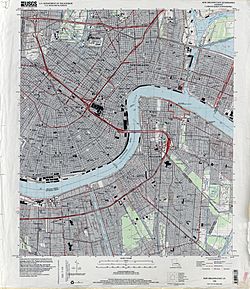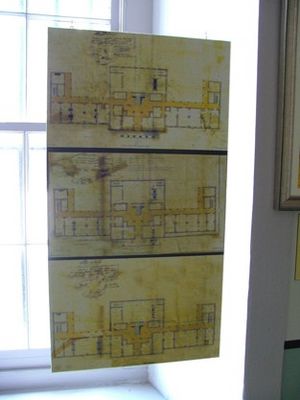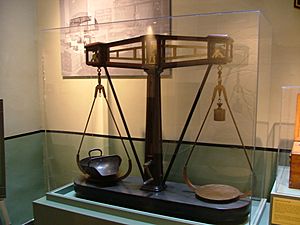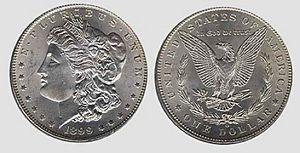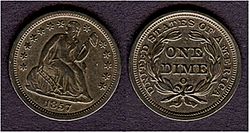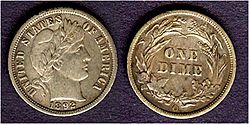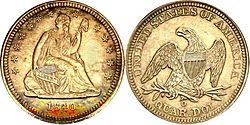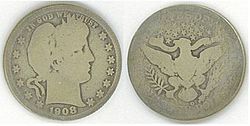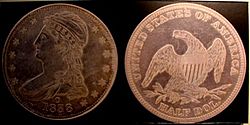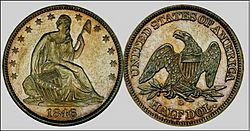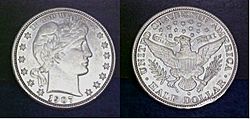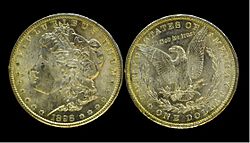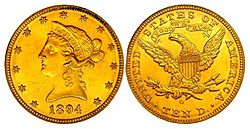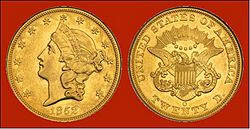New Orleans Mint facts for kids
|
United States Mint, New Orleans Branch
|
|

A postcard from 1907 showing the New Orleans Mint when it was still making coins.
|
|
| Location | New Orleans Louisiana, U.S. |
|---|---|
| Built | 1835 |
| Architect | William Strickland |
| Architectural style | Greek Revival |
| NRHP reference No. | 73000875 |
Quick facts for kids Significant dates |
|
| Added to NRHP | March 30, 1973 |
| Designated NHL | May 15, 1975 |
The New Orleans Mint was a factory for making money in New Orleans, Louisiana. As a branch of the United States Mint, it operated from 1838 to 1861 and again from 1879 to 1909. During that time, it produced more than 427 million gold and silver coins.
The building stopped being a mint a long time ago. It was used as a storage facility for the United States Coast Guard and even a fallout shelter. Since 1981, it has been a branch of the Louisiana State Museum. After being damaged by Hurricane Katrina in 2005, the museum reopened in 2007.
Today, you can visit the museum to see exhibits about New Orleans jazz music, including instruments played by famous musicians. The building is also a National Historic Landmark and is the oldest U.S. Mint building still standing.
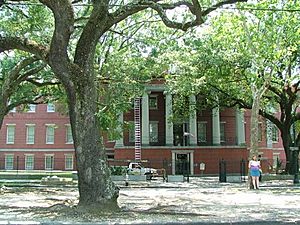
Contents
History of the Mint
Why Build a Mint in New Orleans?
In the 1830s, the United States didn't have enough coins for everyone. People often used foreign money for everyday shopping. The U.S. government decided to build three new mints in the South to solve this problem.
New Orleans was chosen for a few key reasons:
- It was a major port city on the Mississippi River, making it a center for trade.
- Large amounts of gold from Mexico passed through the city.
- It was close to gold deposits discovered in Alabama.
The other two new mints, in North Carolina and Georgia, only made gold coins. The New Orleans Mint made both gold and silver coins, making it the most important branch mint in the country for many years.
The spot where the mint was built is also historic. It was once the site of Fort St. Charles, a fort built by the Spanish in 1792 to defend the city.
Building the Mint
The Mint was designed by architect William Strickland in the Greek Revival style. This style was popular for important government buildings and was meant to look like ancient Greek temples. Strickland also designed the mints in Philadelphia, Charlotte, and Dahlonega.
The building has a large porch, or portico, with four tall Ionic columns in the front. Inside, the building is shaped like a "W" with two open courtyards in the back. The floors are supported by strong brick arches and steel beams.
Fixing a Sinking Building
Strickland didn't consider that New Orleans is built on swampy ground. The soft soil caused the building's foundation to shift, creating structural problems. In the 1850s, an army engineer named P.G.T. Beauregard was hired to fix the building. He strengthened the foundation and made the building fireproof.
Just a few years later, Beauregard became a famous general for the Confederacy during the American Civil War.
The First Coins
The New Orleans Mint started making its first coins on May 7, 1838. The first coins struck were dimes. Until 1861, the mint produced many types of silver and gold coins, including three-cent pieces, half dimes, quarters, half dollars, and gold dollars. It also made larger gold coins called eagles and double eagles.
The Civil War Era
Secession and Confederate Control
In 1861, Louisiana seceded (or broke away) from the United States and joined the Confederacy. The New Orleans Mint was taken over by the Confederate government. For a short time, the Confederacy used the mint to make its own coins. They produced nearly one million half-dollar coins in 1861. They even created a special design for a Confederate half-dollar, but only four of those coins are known to exist today.
Coining stopped in April 1861 when the mint ran out of silver and gold. The building was then used to house Confederate soldiers.
Union Army Occupation
In 1862, Union forces captured New Orleans. When U.S. Marines raised an American flag over the mint, a local man named William Bruce Mumford climbed to the roof and tore it down. The Union general in charge of the city, Benjamin Butler, had Mumford executed for this act. This event became a famous story of Southern resistance.
The mint was closed for the rest of the war and for several years after. It reopened as an assay office (a place to test the purity of metals) in 1876. New machinery was sent, and the building was repaired. In 1879, it started making coins again.
A Second Chance: 1879–1909
Making Coins Again
The mint reopened mainly to produce silver dollars. In 1878, the U.S. government passed a law requiring a large amount of silver to be turned into coins. The New Orleans Mint was needed to help meet this demand. It produced millions of the famous Morgan silver dollar between 1879 and 1904.
During this time, the mint also made dimes, quarters, half dollars, and gold coins. All coins made in New Orleans have an "O" mint mark on the reverse (back) side to show where they were made. Coins from the New Orleans Mint sometimes have a reputation for being less sharply struck than coins from other mints. This makes well-struck "O" mint coins very valuable to collectors today.
Women at the Mint
While most workers at the mint were men, women also played an important role during its second period of operation. About forty-four women were employed, with most working as "adjusters." Their job was to weigh blank coins, called planchets, and file them down to the exact weight before they were stamped.
The work required great care. To keep the sensitive scales from being disturbed by drafts, the windows and doors were kept shut. This made the workrooms very hot, especially in the New Orleans climate.
The Mint in Modern Times
Closure and New Uses
By the early 1900s, the U.S. had enough mints to meet the country's needs. In 1909, the government stopped funding the New Orleans Mint, and it was officially closed in 1911.
After it closed, the building served many purposes. It was a federal prison until 1943 and later a storage facility for the Coast Guard. For many years, the building was neglected and began to decay. During the Cold War, it was even designated as the city's best fallout shelter in case of a nuclear attack.
In 1965, the state of Louisiana took over the building and saved it from being demolished. Between 1978 and 1980, it was renovated and turned into a museum.
The Mint Today
Since 1981, the Mint building has been a museum. It has exhibits on the history of coin making, New Orleans Mardi Gras, and jazz music. The third floor holds the Louisiana Historical Center, which has a collection of old maps and documents from the state's colonial past.
The Mint is one of five branches of the Louisiana State Museum in the French Quarter. It stands as a monument to the city's rich history of commerce, music, and culture.
Coinage Produced
The New Orleans Mint produced a wide variety of silver and gold coins. All coins made here can be identified by the "O" mint mark on the reverse side.
Silver Coins
Gold Coins
See also
 In Spanish: Casa de Moneda de Nueva Orleans para niños
In Spanish: Casa de Moneda de Nueva Orleans para niños


